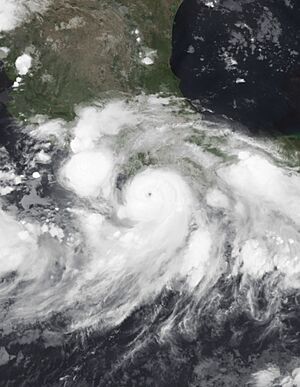Hurricane John (2024) facts for kids

John at peak intensity while it approached the coast of Mexico early on September 24
|
|
| Meteorological history | |
|---|---|
| Formed | September 22, 2024 |
| Category 3 tropical cyclone | |
| 1-minute sustained (SSHWS/NWS) | |
| Highest winds | 120 mph (195 km/h) |
| Lowest pressure | 959 mbar (hPa); 28.32 inHg |
| Overall effects | |
| Fatalities | 3 total |
| Areas affected | Southern Mexico (especially Oaxaca and Guerrero) |
|
Part of the 2024 Pacific hurricane season |
|
Hurricane John was a strong storm that formed in the Pacific Ocean near Mexico. It was the eleventh tropical storm, fourth hurricane, and second major hurricane of the 2024 Pacific hurricane season. John started as an area of low pressure off the coast of Southern Mexico. This low area grew into a tropical depression on September 22, 2024. The next morning, it became Tropical Storm John.
The storm quickly grew much stronger, turning into a Category 3 hurricane on September 24. At this strength, Hurricane John hit land in Marquelia, Guerrero, Mexico, later that day. Once it moved inland, John quickly became weaker and disappeared over Mexico. However, parts of the storm's clouds and winds moved back over the ocean. The very next day, the storm re-formed into a tropical storm off the coast of Southern Mexico.
When John first formed on September 22, warnings were put out for parts of Guerrero and Oaxaca. As the storm got stronger, some of these warnings became hurricane warnings. More than 80 emergency shelters were made ready, and 3,000 people moved to safer places. After John hit land, areas along the coast had mudslides. Over 250 mm (10 inches) of rain fell in parts of Guerrero and Oaxaca. More than 98,000 people in Oaxaca lost power. As of September 25, three people had sadly died because of the storm.
Contents
How the Storm Formed and Moved
On September 21, an area of low pressure with rain and thunderstorms began to form off the coast of Southern Mexico. The next day, this system became more organized. It developed a clear center, leading to the creation of Tropical Depression Ten-E. This happened on the afternoon of September 22, about 280 km (175 miles) south of Punta Maldonado, Guerrero.
The system continued to grow stronger that night. It became Tropical Storm John early on September 23. John moved slowly toward the north-northeast on September 23. It started to get much stronger very quickly. It became a Category 1 hurricane at 5:45 PM UTC on the same day. Just nine hours later, it reached Category 3 major hurricane strength. Its winds were about 195 km/h (120 mph).
At this strong intensity, John hit land in Marquelia, Guerrero. This was about 40 km (25 miles) northwest of Punta Maldonado, at 3:20 AM UTC on September 24. Once John moved over land, it quickly lost its strength. Its winds dropped to tropical storm levels about 12 hours later. By 6:00 PM UTC on September 24, John had disappeared over the mountains of Southern Mexico.
However, a long area of low pressure formed from what was left of John. This area caused a lot of rain and thunderstorms. It started to get organized again on September 25. Ships in the area reported that the air pressure was dropping a lot. By 3:00 PM UTC, John had re-formed into a tropical storm.
Getting Ready for the Storm
When John first became a tropical storm at 9:00 PM UTC on September 22, a Tropical Storm Watch was put in place. This covered the area from Punta Maldonado, Guerrero, to Salina Cruz, Oaxaca. At 9:00 AM UTC the next day, this changed to a Tropical Storm Warning from Punta Maldonado to Huatulco. A Tropical Storm Watch then extended to Salina Cruz.
A Hurricane Watch was also announced for the area under the Tropical Storm Warning. This Hurricane Watch was upgraded to a Hurricane Warning a few hours later. A red emergency alert was given for the states of Guerrero and Oaxaca. John was a threat to parts of Mexico that were still recovering from Hurricane Otis the year before. Otis also got very strong very quickly.
Tourists in Puerto Escondido, Oaxaca, were told to leave by the Secretariat of Civil Protection (SSPC). Businesses across the city closed down. The Puerto Escondido International Airport also closed while the storm lasted. More than 80 emergency shelters were made ready, and 3,000 people were moved to safety. The Federal Electricity Commission (CFE) sent over 1,400 electricians. They also sent cranes and emergency power plants to help with power outages. Schools were closed in Guerrero and Oaxaca to keep students safe.
What Happened After the Storm
The morning after John hit land, the Governor of Guerrero, Evelyn Salgado, shared some news. She reported that two people had died because of a landslide in Tlacoachistlahuaca. Areas along the coast experienced mudslides. Also, the tin roofs were blown off many houses.
Over 250 mm (10 inches) of rain fell in parts of Guerrero and Oaxaca. This happened within the first few hours after John made landfall. More than 98,000 people in Oaxaca lost power. In Oaxaca, 18,000 members of the armed forces and government workers were sent to help with emergency efforts. Very heavy rains also fell in the nearby states of Chiapas, Veracruz, Michoacán, and Puebla.
See also
- Weather of 2024
- Tropical cyclones in 2024
- Hurricane Pauline (1997) – deadly storm that followed a similar track
- Hurricane Carlotta (2012) – followed a similar track
- Hurricane Agatha (2022) – affected the same area

